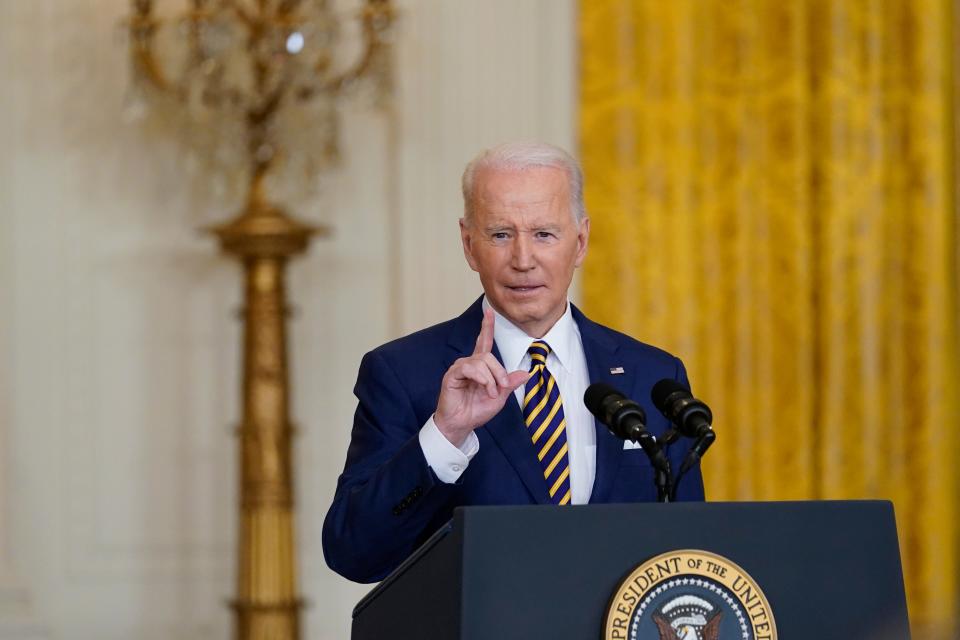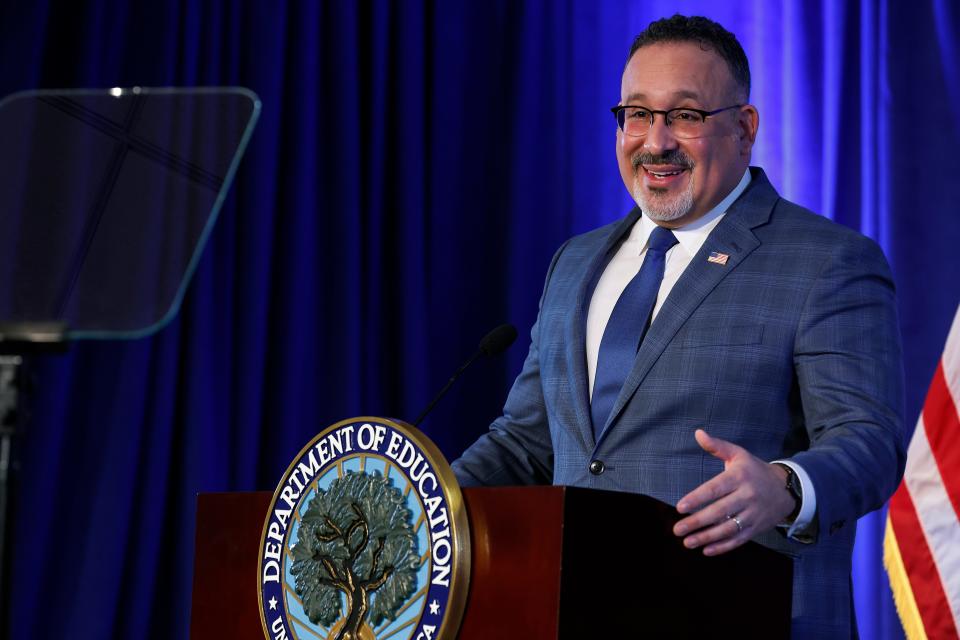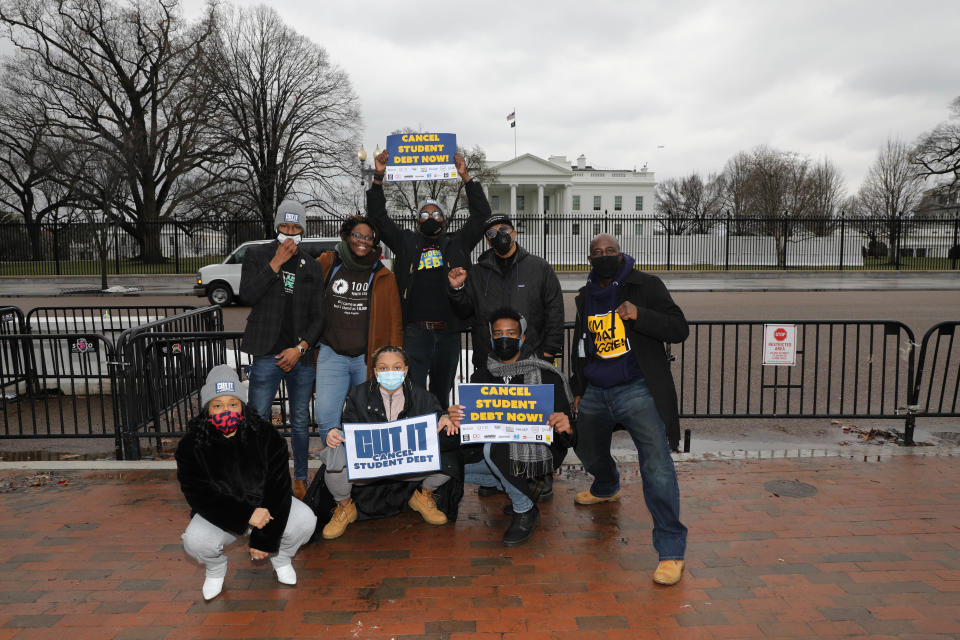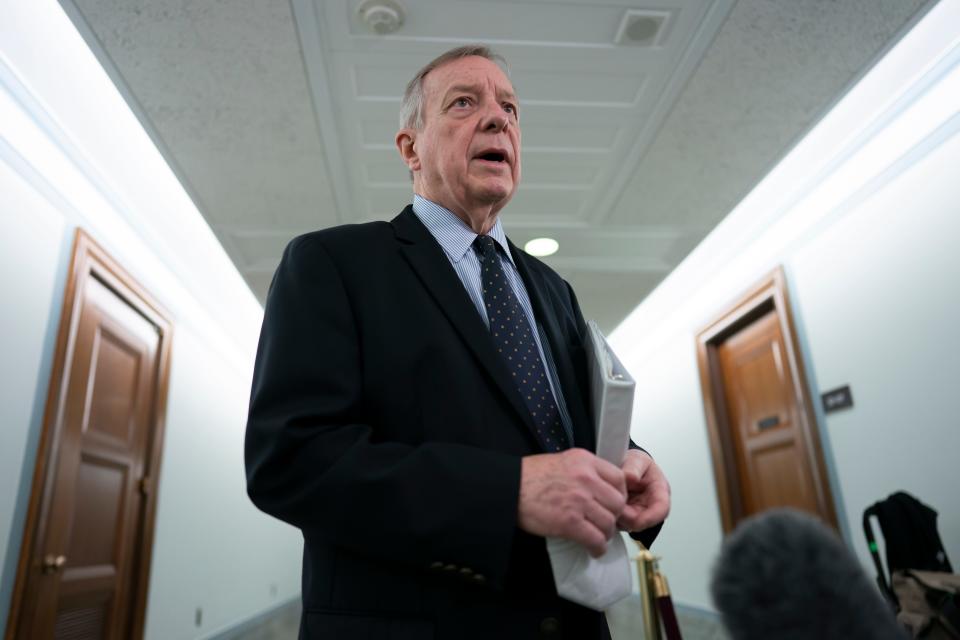Bankruptcy very rarely erases student loans. Even when it does, the US government has put up a fight
- Oops!Something went wrong.Please try again later.
WASHINGTON – In January, Ryan Wolfson pulled off the rare feat of wiping out nearly $100,000 in student loans through bankruptcy.
Wolfson, 35, accumulated the debt earning a business degree from Penn State University in 2010. But he filed for bankruptcy in 2019 after hundreds of career job interviews failed to yield any offers. He scraped by driving for Uber, GrubHub and DoorDash, but after crashing his car while suffering an epileptic seizure, he gave up his apartment, moved in with his father and asked the court to eliminate his student loans.
Days after a bankruptcy judge ruled in Wolfson's favor to erase his loans, the Biden administration filed a notice of appeal to U.S. District Court, putting up a final fight without explaining why. When advocates for borrowers of student loans griped and Wolfson's case generated news coverage, the Department of Education quickly dropped the appeal Feb. 4, saying in a tweet it would review future cases.
“At that moment, I was really, really upset,” Wolfson told USA TODAY. “I was like, ‘Why are they doing this to me again?’”
Far-right fundraising: Mimicking Donald Trump, far-right lawmakers use personal celebrity to draw in donors
Four days after dropping Wolfson's appeal, the administration filed a notice of appeal in a similar case. Monique Wheat, a single mother of three from Alabama, represented herself in bankruptcy court, where a judge ruled her $111,000 in student debt would be forgiven. At one point during the case, Justice Department lawyers suggested her then-13-year-old son might be able to get a job at 14 to add to the household income. The government dropped its appeal Feb. 11 – again, without explanation.
More: Do you have student debt? Here are ways to get loan forgiveness under new federal rules
Despite President Joe Biden's campaign vow to ease the burden on people who owe student loans, federal lawyers across the U.S. continue to challenge bankruptcy rulings for some of the most desperate borrowers, who meet a high legal standard to have their debt forgiven. The challenges persist even though Biden administration officials acknowledge the legal hurdles to wipe out debt are too strict in the first place.
The scope of the problem is staggering. About 250,000 people with student loans declare bankruptcy each year. But only about 1 in 1,000 are able to wipe out education debt, which requires proof the debt imposes an "undue hardship." The legal hurdles discourage many student borrowers from even trying.
Cases like Wolfson's and Wheat's also reveal Biden's complicated history with student loans.
In his 36 years in the Senate, Biden repeatedly joined big majorities in Congress making it harder to erase student loans through bankruptcy. But Biden also pledged relief for student borrowers during the 2020 campaign, including rolling back some of the bankruptcy laws he helped pass.
Bankruptcy attorneys and judges, student loan advocates and senior Democratic lawmakers say the bankruptcy standards for student loans – which are higher than other forms of debt – are too burdensome.
"It’s crushing too many people right now," said Ed Boltz, a bankruptcy lawyer in Durham, N.C., told USA TODAY.

Richard Cordray, chief operating officer for the U.S. Department of Education’s office of Federal Student Aid, told a House panel in October the bankruptcy process doesn't work well and needs to be overhauled.
He said the Education and Justice departments would review policies where people “are forced to go into court, if you can imagine such a thing, and recount how miserable their lives are, in order to beg for some kind of bankruptcy relief and rarely get it.”
"I think that it doesn't work well, and we think that it needs to be reformed and reevaluated, and we are committed to doing that," Cordray said.
But Cordray didn't explain why the government pursues appeals in cases like that of Wolfson's and Wheat's. Government and private lenders regularly appeal when student loans are discharged in cases that aren't settled before trial, according to bankruptcy lawyers and professors.
Meanwhile, student debt continues to grow on a larger scale.
About 43 million borrowers owe about $1.6 trillion, according to Education Department statistics. The Trump administration suspended loan payments in March 2020 amid the coronavirus pandemic, and Biden has extended the suspension until May 1. But the number of people seeking relief from student loans before the pandemic was enormous, and the debt continues to mount despite the payment moratorium.
Student loans to be repaid: $415 million of federal loan money sent to students defrauded by DeVry, ITT Tech
It's harder to wipe out student loans in bankruptcy than other debt
Wolfson and Wheat are two of the few people who succeeded in canceling their education debt through bankruptcy.
About 300 debtors a year get relief from student loans in bankruptcy court out of about 250,000 who filed, according to estimates from Jason Iuliano, an associate professor of law at the University of Utah, whose figures based on court records are supported by legal experts in the field.
More: Do you have student debt? Here are ways to get loan forgiveness under new federal rules
The low success rate is because the process for wiping out student debt through bankruptcy requires an extra legal step, a filing to prove "undue hardship," which most student debtors often don't take because of the legal challenges and cost.
The prevailing court precedent that defined undue hardship in 1987 was called Brunner vs. New York Higher Education Services Corp. The Brunner case created a three-pronged test to qualify for forgiveness: the debtor must be unable to maintain a minimal standard of living, the situation is likely to persist and the debtor must have made a good-faith effort to repay the loan.
Student loan forgiveness: Student loan forgiveness has arrived for 70,000 borrowers working public service jobs
Government lawyers typically challenge student loan cases by arguing that even if finances are dire when a case is filed, the borrower could eventually find a better job and repay the loan. The cases put the debtor in the position of arguing against the success of their own future employment.
Boltz said the Education Department and the nonprofit Educational Credit Management Corp., which collects student loans, "always wage a scorched-earth war on student loans."
"They want everybody to know it’s not going to be easy" to get out of their loans, Boltz told USA TODAY. "It’s going to be very difficult."
How it got so difficult can be traced to Congress.

Over the years, Biden and Congress toughened student loan forgiveness laws
Congress steadily made it harder to discharge student loans through bankruptcy over decades, and Biden supported at least five of those incremental changes in the Senate. Wolfson and Wheat faced the culmination of those legal hurdles in their cases.
The changes began in 1976 to prevent anyone from filing for bankruptcy within five years of graduation unless they could prove undue hardship. A series of other changes in 1979, 1990, 1998 and 2005 eventually extended the undue hardship standard to all student loans no matter when they were filed.
“Sen. Biden was not very easy on student loans," said Boltz, the bankruptcy lawyer who called the current undue hardship standard "really, really draconian and brutal."
“It’s been applied far, far harsher than it ever could have or should have," Boltz said.
How Congress tightened bankruptcy laws affecting student loans with Biden's support
Without singling out student debtors, Biden argued at a February 2001 hearing that “something’s rotten in Denmark” because so many people were declaring bankruptcy during a booming economy.
“An awful lot of people are discharging debt that shouldn't,” Biden said. “Something's going on here. And it says to me it's got to be tightened.”
Biden said during a March 2020 presidential debate on CNN that he didn't like the 2005 legislation but that he worked with Republicans to improve it. One of the bill's provisions required undue hardship to wipe out private student loans in addition to government loans. At the time, he was campaigning against Sen. Elizabeth Warren, D-Mass., who proposed to forgive $50,000 in student loans for each borrower and eliminate the onerous undue hardship standard.
"I did not like the rest of the bill, but I improved it," Biden said of the 2005 measure.
Biden pledged during the campaign to "end the absurd rules that make it nearly impossible to discharge student loan debt in bankruptcy." He also campaigned for "an immediate cancellation of a minimum of $10,000 of student debt per person."
But lawyers and student advocates doubt Biden will overhaul bankruptcy law.
"He had no intention of doing that," Austin Smith, a New York bankruptcy lawyer, told USA TODAY. "He has instructed his Department of Education to fight these things tooth and nail, which I think is really unforgivable."
Pamela Foohey, a bankruptcy law professor at Cardozo Law School in New York, said potential administration changes in how bankruptcy cases should be handled should happen more urgently.
"I think they could work faster," Foohey told USA TODAY. "It’s been too long."
At his January news conference, Biden breezed past a question about forgiving $10,000 per borrower in student debt but has said he would sign legislation if Congress approves it.
Student loan payment pause: Biden extends federal student loan payment pause through May 1
Trapped under six-digit debts
The White House and the Department of Education did not explain why they appealed in Wolfson's and Wheat's cases or why they dropped the efforts in both cases days later.
For Wolfson, the bankruptcy filing came after a decade scrambling for minimum wage jobs and driving gigs. Career options dwindled as years passed without a 9-to-5 job and his cannabis use to treat epilepsy prevented him from taking work requiring a drug test, he said.
“I’ve been fighting battles my whole life when the odds are stacked against me," Wolfson said. "To me, does it make it hard? Yes. But does it scare me from fighting that battle? No.”
U.S. Bankruptcy Judge Laurie Selber Silverstein ruled Jan. 14 that Wolfson faced undue hardship from the debt.
“Since graduating from college, this debtor could not afford a modest apartment, food to eat or basic transportation without the assistance of his father,” Silverstein wrote in her decision. “It is not for lack of work ethic. His assortment of jobs, even while working full time, did not permit repayment of his student loans. As there is no evidence to suggest his plight will improve, Wolfson is entitled to a discharge.”

Education Secretary Miguel Cardona filed a notice of appeal to the U.S. District Court in Delaware on Jan. 28. But a week later, Cardona dropped the appeal without explanation.
"Beyond our notice to withdraw, we have no additional details to share," said Kim Reeves, a spokeswoman for the U.S. attorney's office in Delaware.
The same thing happened to Wheat, who at 32 was raising three children ages 8 to 12 in a federally subsidized apartment, according to court records. She filed for bankruptcy in 2018, when her monthly expenses totaled $2,954 and her net income was $1,876, according to court records.
Wheat had accumulated about $111,000 in student loan debt while earning a bachelor’s degree in criminal justice from Troy University and attending a master’s program in clinical counseling at Bellevue University, according to court records.
But Wheat, who tends to her mother's and daughter's health ailments, was unable to find a job in her field and earned $10.50 an hour a few days a week at a nearby medical center, according to court records.
The Justice Department, representing the Education Department, opposed her by arguing her situation didn't represent a "certainty of hopelessness."
U.S. Bankruptcy Judge William Sawyer rejected the government's arguments and ruled Jan. 25 that Wheat faced undue hardship from the debt. The Education Department filed a notice of appeal to U.S. District Court on Feb. 8 before withdrawing it three days later.
More: Student loan forgiveness has arrived for 70,000 borrowers working public service jobs
Iuliano, who researches bankruptcy cases, said few student loan rulings are appealed because the vast majority are settled. Iuliano and bankruptcy lawyers say the settlements are part of a strategy by creditors to avoid a precedent that would embolden others to pursue student loan forgiveness in bankruptcy.
Smith said creditors have gone so far as to appeal cases involving paraplegics living on state assistance.
“I have never seen them not appeal," Smith said. “It’s almost like a mafia tactic so people on the street don’t think they’re weak."
Pressed about Wolfson’s case and student loan debt in recent press briefings, White House spokeswoman Jen Psaki deferred to the federal agencies, reiterated Biden's willingness to erase $10,000 in debt and pointed out he has forgiven student loans in specific cases such as for students with permanent disabilities or when a school goes defunct.
“The president has forgiven $15 billion in student loans benefiting more than 675,000 student loan borrowers since he took office," Psaki said in response to a question from USA TODAY. "No one has been required to pay a single dime in federal student loans. And he extended the hiatus of payment until May to give people some extra breathing room.”
The Education Department said in a brief statement that it’s working with the Justice Department “to explore legal pathways to delivering targeted relief to borrowers."
Wolfson's case was provocative enough to draw the attention of a top Education Department official and national news stories.
James Kvaal, the undersecretary of education, said in a tweet the day the appeal was dropped that the department would review how future claims are handled.

Signs of pushback from judges
Legal experts say there are signs judges are beginning to push back against creditors in student loan cases, as seen in cases such as Wolfson's and Wheat's.
In a New York case, U.S. Bankruptcy Judge Cecelia Morris railed against the “myths” that debtors can’t erase their student loans through bankruptcy court because of how the Brunner standard has been applied.
Her 2020 ruling wiped out $221,385 in student loan debt for Kevin Rosenberg of Beacon, New York. He had earned a bachelor’s degree at the University of Arizona in 1996 and a law degree from Cardozo Law School in 2004, sandwiched around two stints in the Navy.
Rosenberg left the legal profession quickly to open a business selling camping equipment in Brooklyn, which he said yielded more than $100,000 in income some years. But the business suffered and he filed for bankruptcy in 2018, when he was earning about $1,500 per month less than expenses while still facing huge debt.
“If those loans are allowed to stand, I have no chance at having a life," Rosenberg told USA TODAY. "I’m basically just an indentured servant working to pay off my loans and never actually benefitting from them."
In discharging Rosenberg’s student loans, Morris found interpretations of the Brunner case yielded "harsh" results because judges treated the standards as "punitive."
Not just the Supreme Court: Biden poised to triple number of Black women on federal appeals courts
“Brunner has received a lot of criticism for creating too high of a burden for most bankruptcy petitioners to meet,” Morris said in her ruling. “The court will not participate in perpetuating these myths.”
The Educational Credit Management Corp., which took over collection of Roseberg's payments, appealed her decision to the U.S. District Court, which sent the case back to Morris for a full trial that is still pending.
New York Attorney General Letitia James filed an argument supporting Rosenberg in the case by arguing the legal regime and practical experience had changed in the decades since the Brunner test, with "vastly increased" student debt that led to "a nationwide crisis in student debt."
“I think they appeal everything just to scare people as well," Rosenberg said of student loan creditors.
How could student loan bankruptcies change?
Lawmakers have urged more action on loan forgiveness and on a bankruptcy overhaul, but disagree about which steps to take. Congress' top-ranking Democrats, Senate Majority Leader Chuck Schumer and House Speaker Nancy Pelosi disagree over whether Biden has the authority to forgive even $10,000 in federal debt for each borrower.
Sen. Dick Durbin of Illinois, the second-ranking Democrat in the Senate, said “meaningful progress” was still possible this year. The Judiciary Committee chairman said the Education Department could take administrative steps to change its approach to contesting bankruptcy cases involving student loans.

“The student debt crisis demands action, both from Congress and from the Department of Education,” Durbin told USA TODAY. “It’s become clear that current bankruptcy law, which requires a nearly impossible showing of ‘undue hardship’ to obtain student loan relief, simply does not work.”
Sen. Patty Murray, D-Wash., who heads the Health, Education, Labor and Pensions Committee, supported a bankruptcy bill spearheaded by Durbin, which aimed to clarify undue hardship and to remove the undue hardship requirement for private student loans. She also supported forgiving $10,000 in loans per borrower.
“Right now, student loan borrowers are struggling under the burden of student debt and they need relief,” Murray told USA TODAY in a statement.
But Rafael Pardo, a professor at Emory Law School who specializes in bankruptcy law, said change in the undue hardship standard would have to come from bankruptcy courts because Congress is unlikely to act. Creditors have greater economic resources to fight changes than nonprofit groups that advocate for borrowers, he said.
As the administration reviews its options, bankruptcy law professors and lawyers who represent people with student loans have proposed the department not automatically challenge bankruptcy relief for student loans.
Smith, the bankruptcy lawyer, suggested turning back the bankruptcy clock decades so that debtors would erase student loans after five years without proving undue hardship.
"I think the term is just fundamentally rotten at this point," Smith said. "There are enough negative side effects of bankruptcy that being discouraged is already built into it."
More: Online college accused of recruiting unprepared students, pocketing money – despite sanctions
Another option would be for the department to acquiesce on bankruptcies with smaller amounts of student loans, such as $5,000 or $7,500, because the cost of litigation could outweigh those amounts.
“Whatever has been going on, it’s a political question," Dalie Jimenez, who studies bankruptcy law as a professor at UC Irvine and as director of the Student Loan Law Initiative. “It is still very frustrating."
This article originally appeared on USA TODAY: When bankruptcy eliminates student loan debt, government fights back

